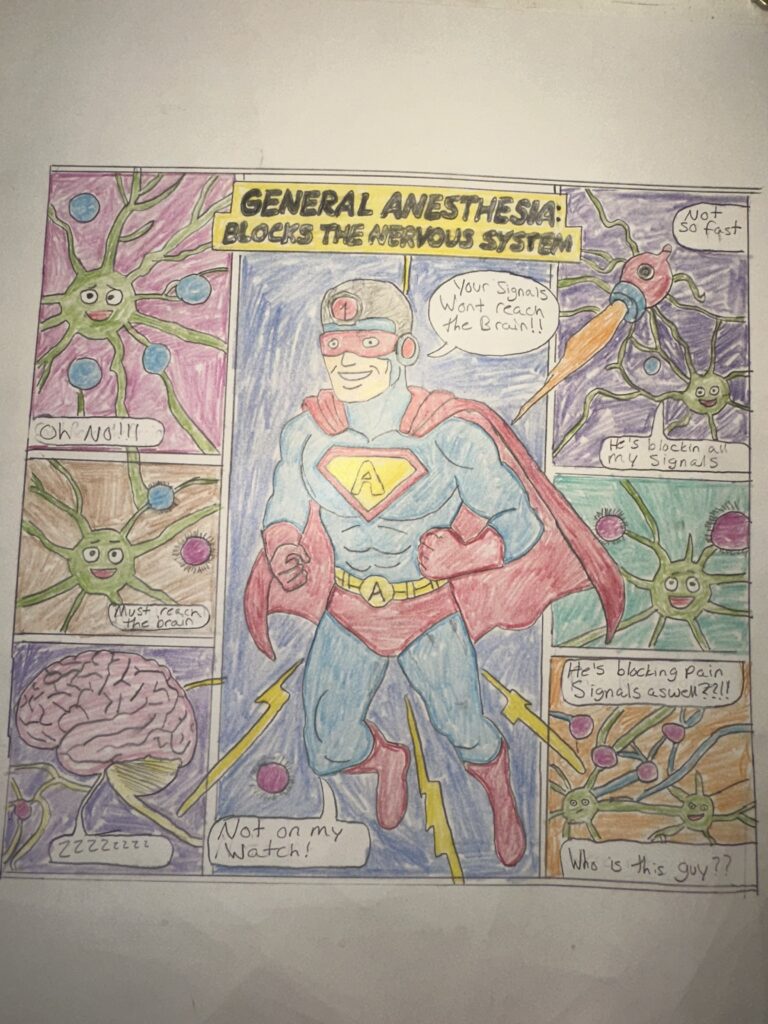
My steam project relates to the objective “Explain how neurons carry an electrical charge”.
There are several different types of anesthesia used for various medical purposes, but I will be focusing on general anesthesia. General anesthesia is most commonly used for major surgeries and is administered by medical professionals to put a patient into a state of unconsciousness. This is so the patient is still for the operation but most importantly so they won’t feel any pain during the surgery.
How does general anesthesia work?
According to the article “Molecular Mechanisms of General Anesthesia” from the Korean Journal of Anesthesiology (KJA), general anesthesia works by creating a state called neuro-depression where the central nervous system is significantly less active. This is due to the anesthetic drug altering different neurotransmitters, specifically by enhancing inhibitory neurotransmission and reducing excitatory neurotransmission. General anesthetics target different neurotransmitters as well as voltage-gated ion channels. General anesthetics primarily target GABAA receptors which are responsible for the transmission of GABA. Gamma-aminobutyric acid (GABA) is an inhibitory neurotransmitter that reduces neuronal excitability by preventing nerve transmission. General anesthetics strengthen the effects of GABA therefore enhancing the block of nerve transmission and leading to a state of unconsciousness. (Son, 2010)
Protein receptor’s roles and anesthesias effect on them.
According to the article “How General Anesthetics Work: from the Perspective of Reorganized Connections within the Brain” from the KJA, general anesthetics are highly lipid soluble allowing them to diffuse across the lipid bilayer into neurons where they target different protein receptors. There are two classes of receptors that help maintain consciousness, inhibitory and excitatory. These receptors have two distinct functions, inhibitory receptors reduce brain activity while excitatory receptors increase brain activity. Anesthesia enhances inhibitory receptors such as GABA receptors, therefore greatly decreasing brain activity. It can also be responsible for effects on the patient, such as sedation, amnesia, and anesthesia. Anesthesia blocks excitatory receptors like Glutamate receptors which promote brain activity and are essential for perception, learning, and memory. By blocking these receptors patients under anesthesia cannot form memories and lack perception. (Shin et al., 2022)
I find it easy to understand this by thinking of the brain as a car. If the brain is a car then inhibitory receptors would act as the brake pedal while excitatory receptors act as the gas pedal. When you are conscious, excitatory receptors are constantly sending signals to the brain that keep it active, so the gas pedal is being pushed down and the car is moving. When anesthesia is administered it increases the inhibitory receptors reducing brain activity, so the anesthesia is stepping on the brake and slowing the car down.
How general anesthetics stop neurotransmission.
Neurotransmitters act as chemical messengers and carry signals between neurons in the brain and body that allow us to do things like move limbs, feel sensations, and keep our brains active. For a neurotransmitter to be released, an electrical charge called an action potential must occur within the cell. For the action potential to occur the cell membrane must depolarize by opening voltage-gated sodium channels allowing sodium ions to flow into the cell causing the membrane to become less negative and eventually hit the threshold of -55mV resulting in an action potential spike. According to the article “The Effects of General Anesthetics on Synaptic Transmission”, Anesthesia stops this from happening by blocking the voltage-gated sodium channels so that sodium ions can’t enter the cell, therefore, the cell can not depolarize and create an action potential. By doing this general anesthetics stop the release of excitatory neurotransmitters like glutamate which leads to decreased brain activity and unconsciousness. (Hao et al., 2020)
For my Project, I decided to create a comic page depicting anesthesia as a superhero. In the comic, the superhero “General Anesthesia” is seen disrupting and blocking signals from neurons that are meant to reach the brain. By blocking the signals from reaching the brain general anesthesia puts the brain into a state of unconsciousness.
References
Son, Y. (2010). Molecular mechanisms of general anesthesia. Korean Journal of Anesthesiology, 59(1), 3. https://doi.org/10.4097/kjae.2010.59.1.3
Shin, T. J., Kim, J., & Choi, B. (2022). How general anesthetics work: From the perspective of reorganized connections within the brain. Korean Journal of Anesthesiology, 75(2), 124. https://doi.org/10.4097/kja.22078
Hao, X., Ou, M., Zhang, D., Zhao, W., Yang, Y., Liu, J., Yang, H., Zhu, T., Li, Y., & Zhou, C. (2020). The Effects of General Anesthetics on Synaptic Transmission. Current Neuropharmacology, 18(10), 936. https://doi.org/10.2174/1570159X18666200227125854
